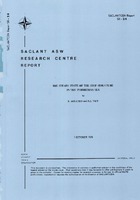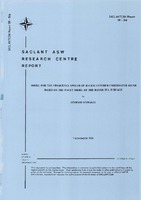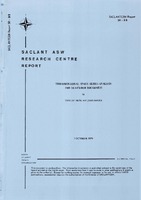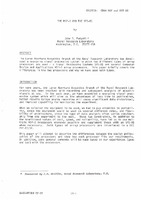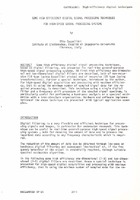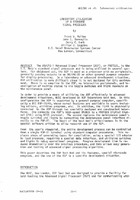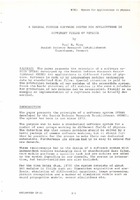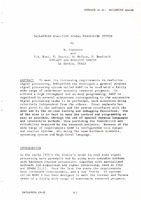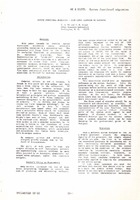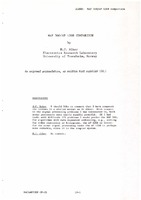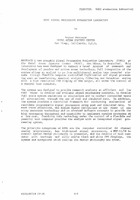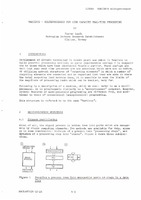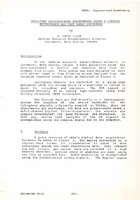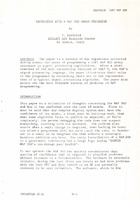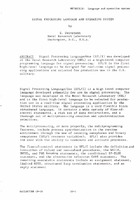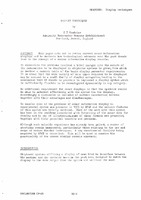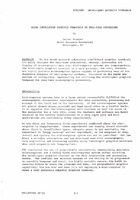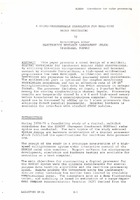Browsing Reprints by Issue Date
Now showing items 121-140 of 548
-
The steady state of the step structure in the Tyrrhenian Sea
(NATO. SACLANTCEN, 1978/10)A deep step structure, in which mixed layers alternate with high gradient interfaces, is a characteristic feature of the Tyrrhenian Sea. Three oceanographic cruises (May 1972, May 1973 and October 1974), supported by the ... -
Model for the frequency spread of backscattered underwater sound based on the facet model of the rough sea surface
(NATO. SACLANTCEN, 1978/11)A theoretical model for the doppler spread of backscattered acoustic waves from the rough sea surface is described on the basis of the decomposition of the continuous sea-surface spectrum that leads to the concept of facets. ... -
Two-dimensional space-series analysis for sea-floor roughness
(NATO. SACLANTCEN, 1979/10)For a quantitative description of the sea-floor roughness, a numerical method has been developed to obtain the two-dimensional power spectrum and the autocorrelation function. The determination of these parameters gives ... -
The MPS-3 and the SPS-81
(NATO. SACLANTCEN, 1979/12)The Larqe Aperture Acoustics Branch of the Naval Research Laboratory has developed a sea-qoinq signal processinq system in which two different types of array processors are used - a Signal Processing Systems SPS-81 and ... -
Some high efficiency digital signal processing techniques for high speed signal processing systems
(NATO. SACLANTCEN, 1979/12)Some high efficiency digital signal processing techniques, based on digital filtering are presented for real-time general-purpose, high-speed signal processing systems. At first high efficiency one-dimensional and ... -
Overview of the ADPS signal processor
(NATO. SACLANTCEN, 1979/12) -
Laboratory utilization of a standard signal processor
(NATO. SACLANTCEN, 1979/12)The AN/UYS-l Advanced Signal Processor (ASP), or PROTEUS, is the U.S. Navy's standard signal processor and is being utilized in several systems. For shipboard use, the ASP is used as a processor with no peripherals, generally ... -
Development of military ARGUS computers and MOD bus for close-coupled signal processing applications
(NATO. SACLANTCEN, 1979/12)The next generation of Naval sonar systems will make extensive use of flexible programable modules to implement signal-processing algorithms. A number of UK Defence Establishments are engaged in a series of coordinated ... -
A general purpose software system for applications in different fields of physics
(NATO. SACLANTCEN, 1979/12)The paper presents the principle of a software system (FTSS) developed by the Danish Defence Research Establishment (DDRE) for applications in different fields of physics. Software is made up by independent modules exchanging ... -
SACLANTCEN real-time signal processing system
(NATO. SACLANTCEN, 1979/12)To meet its increasing requirements in real-time signal processing, SACLANTCEN has developed a general purpose. signal processing system called WARP to be uS.ed with a fairly wide range of underwater acoustic research ... -
System functional migration: high-level language to hardware
(NATO. SACLANTCEN, 1979/12)This paper intends to examine system functional allocation among available processing resources in a systematic way. The discussion will focus first on the criteria for assigning functions to processors, that is, horizontal ... -
MAP 300/AP 120B comparison
(NATO. SACLANTCEN, 1979/12) -
NOSC signal processing evaluation laboratory
(NATO. SACLANTCEN, 1979/12)A new acoustic Signal Processing Evaluation Laboratory (SPEL) at the Naval Ocean Systems Center (NOSC), San Diego, is described. This laboratory has been designed to support a broad program of research and development of ... -
Martinus - multiprocessor for high capacity real-time processing
(NATO. SACLANTCEN, 1979/12)Development of circuit technology in recent years now makes it feasible to build powerful processing machines at quite considerable savings - in comparison to those which have been considered feasible earlier. These savings ... -
Real-time expanded-band beamforming using a complex heterodyner and fast array processor
(NATO. SACLANTCEN, 1979/12)At the Defense Research Establishment Atlantic Dartmouth, Nova Scotia, Canada a data aquisition sytem been engineered to monitor and beamform data from element line arrays. This system has been designed to with either towed ... -
Experience with a MAP 300 array processor
(NATO. SACLANTCEN, 1979/12)The paper is a summary of the experience collected during almost two years of programming a CSPI MAP 300 array ' processor in signal processing applications. After a short overview of the most interesting features of SNAP ... -
Signal-processing language and operating system
(NATO. SACLANTCEN, 1979/12)Signal Processing Language/One (SPL/I) was developed at the Naval Research Laboratory (NRL) as a high-level computer programming language for signal processing. SPL/I is the first high-level language to be designed for ... -
Display techniques
(NATO. SACLANTCEN, 1979/12)This paper sets out to review current sonar information displayc and to indicate how technological advances over the past decade lead to the concept of a common information display console. To appreciate the problems ... -
Using intelligent graphics terminals in real-time processing
(NATO. SACLANTCEN, 1979/12)At the Naval Research Laboratory intelligent graphics terminals are being utilized for real-time acquisition, storage, processing and display of oceanographic data when mini-computer systems are inappropriate. The intelligent ... -
A micro-programmable correlator for real-time radar processing
(NATO. SACLANTCEN, 1979/12)This paper presents a novel design of a multibit, digital correlator for incoherent scatter radar observations. By utilizing bit-slice microprocessor elements and internal control by microcode instructions, a high-speed ...
